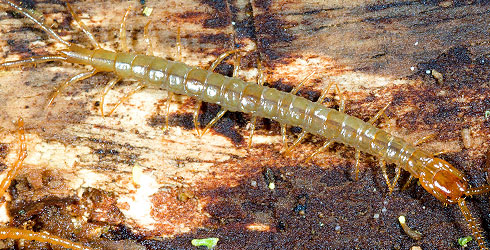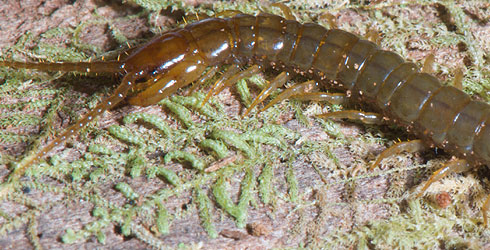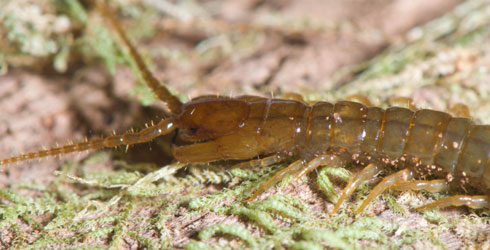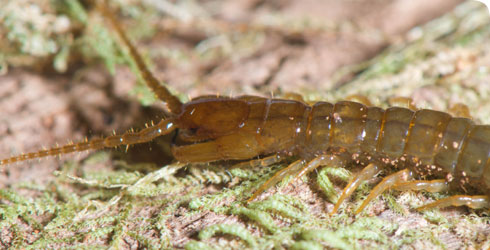Craterostigmus crabilli
Four of the five living orders of centipedes have 100–1,260 described species.
Craterostigmomorpha is the exception - it is an order first described from a single species from Tasmania, Australia, in 1902. For over a century, the order Craterostigmomorpha included only Craterostigmus tasmanianus, recorded from Tasmania and New Zealand.
Genetic studies helped show that the New Zealand populations are distinct from those in Tasmania.
In 2008 Natural History Museum and Harvard scientists named the second species of Craterostigmomorpha, Craterostigmus crabilli (Edgecombe and Giribet, 2008).
Conservation
This species is not considered to be under threat, because it:
- is widely distributed throughout New Zealand
- occurs in different kinds of forests
- has been recorded in many conservation areas
Species detail
-

Taxonomy
Discover what distinguishes C. crabilli from other centipedes, and how scientists are using molecular tools to find out when C. crabilli diverged from C. tasmanianus - its closest relative.
-

Distribution
C. crabilli is found in New Zealand in native forest habitats at different elevations. Find out more.
-

Biology
We know little about C. crabilli’s lifecycle, but its close relative C. tasmanianus gives us clues.
-

References
Get more information on Craterostigmus crabilli.
Images

A specimen from the type locality of Craterostigmus crabilli, collected in moss from southern beech (Nothofagus) forest at Aoraki/Mount Cook National Park, Westland, South Island, New Zealand.
© Gonzalo Giribet
Craterostigmus crabilli from Catlins Forest Park, Southland, South Island, New Zealand.
© Gonzalo Giribet
Scanning electron micrograph of the closely related Australian species Craterostigmus tasmanianus, showing the pair of 'can opener' tooth plates on the maxillipede coxosternite. These are the same in C. crabilli, which has 5–8 (usually 6 or 7) teeth on each tooth plate.
© Sue Lindsay, Australian Museum
Scanning electron micrograph of the posterior part of the body of Craterostigmus crabilli in dorsal view, showing the basal parts of the 15th leg pair. The elongate structure projecting behind the ultimate leg-bearing segment is the anal capsule. This specimen comes from Dunedin, South Island.

Scanning electron micrograph of the posterior part of the body of Craterostigmus crabilli in ventral view, showing the anal capsule opened to reveal eight fields (four on each side) of pores that are openings of the anal glands.

Enlargement of the openings of the anal glands in Craterostigmus crabilli. The depression is the central part of the anal capsule is the anus (Rosenberg et al, 2006).

Craterostigmus crabilli from Kahurangi National Park, Nelson, South Island, New Zealand.
© Gonzalo Giribet
Detail of Craterostigmus crabilli from Kahurangi National Park, Nelson, South Island, New Zealand.
© Gonzalo GiribetAuthor's quote
"Describing a new species of Craterostigmus was a once-in-a-lifetime opportunity - the last time anybody named a species from this order of centipedes was in 1902. It was also the first time that DNA sequence characters had been used as diagnostic features for a centipede species."

